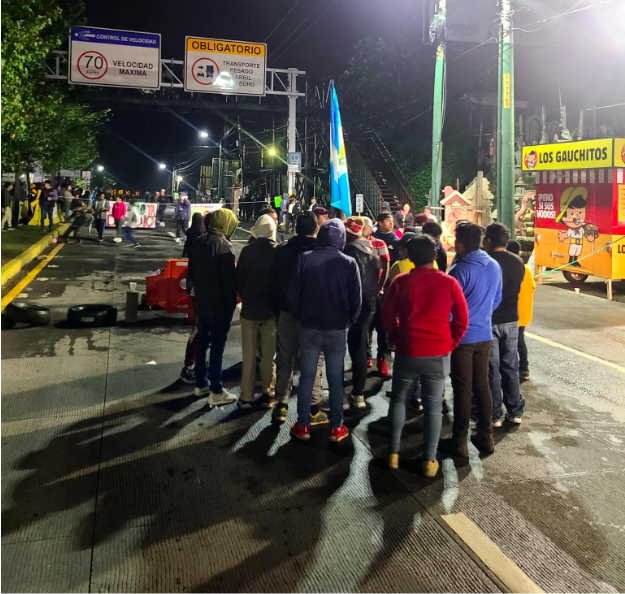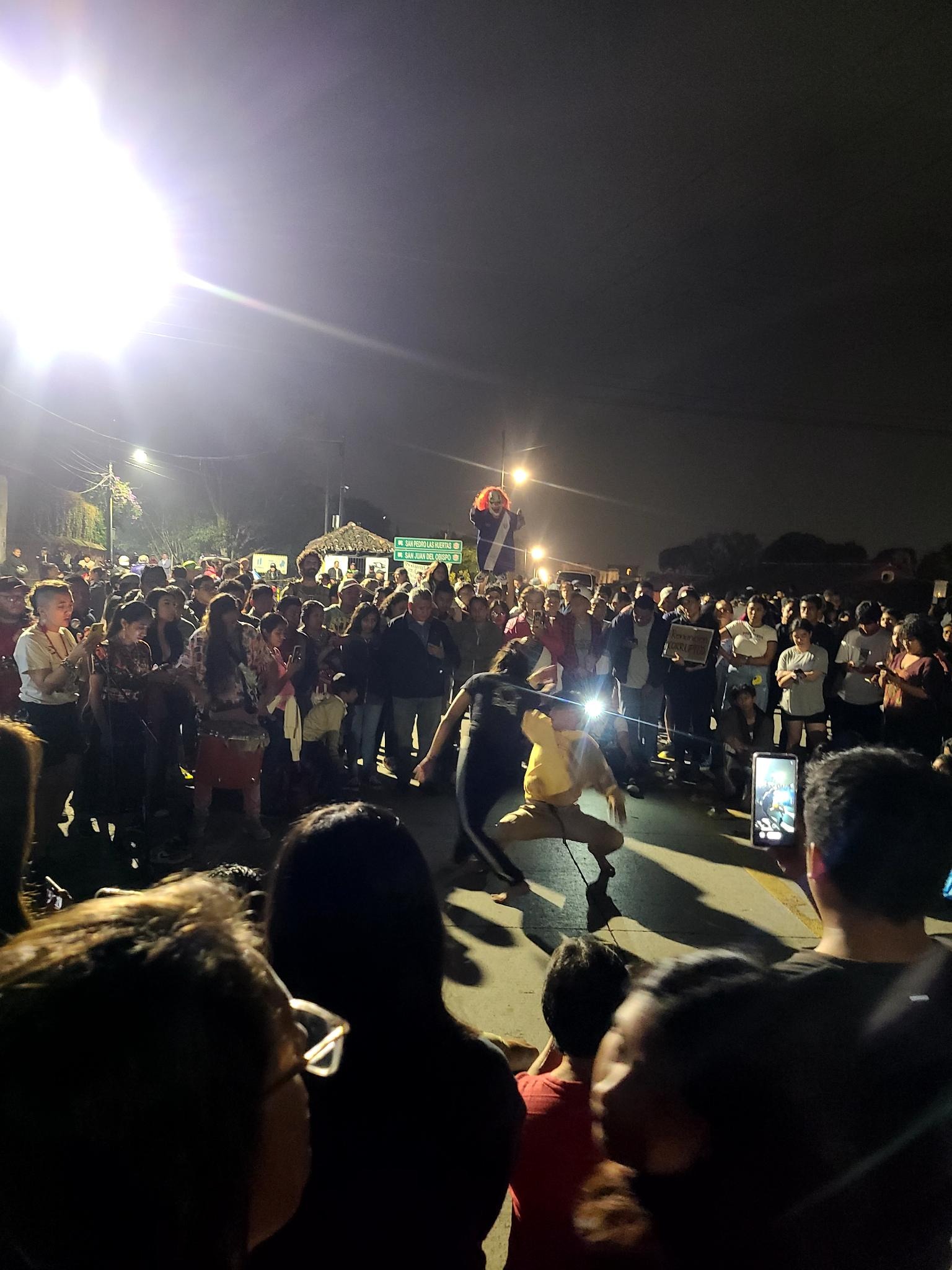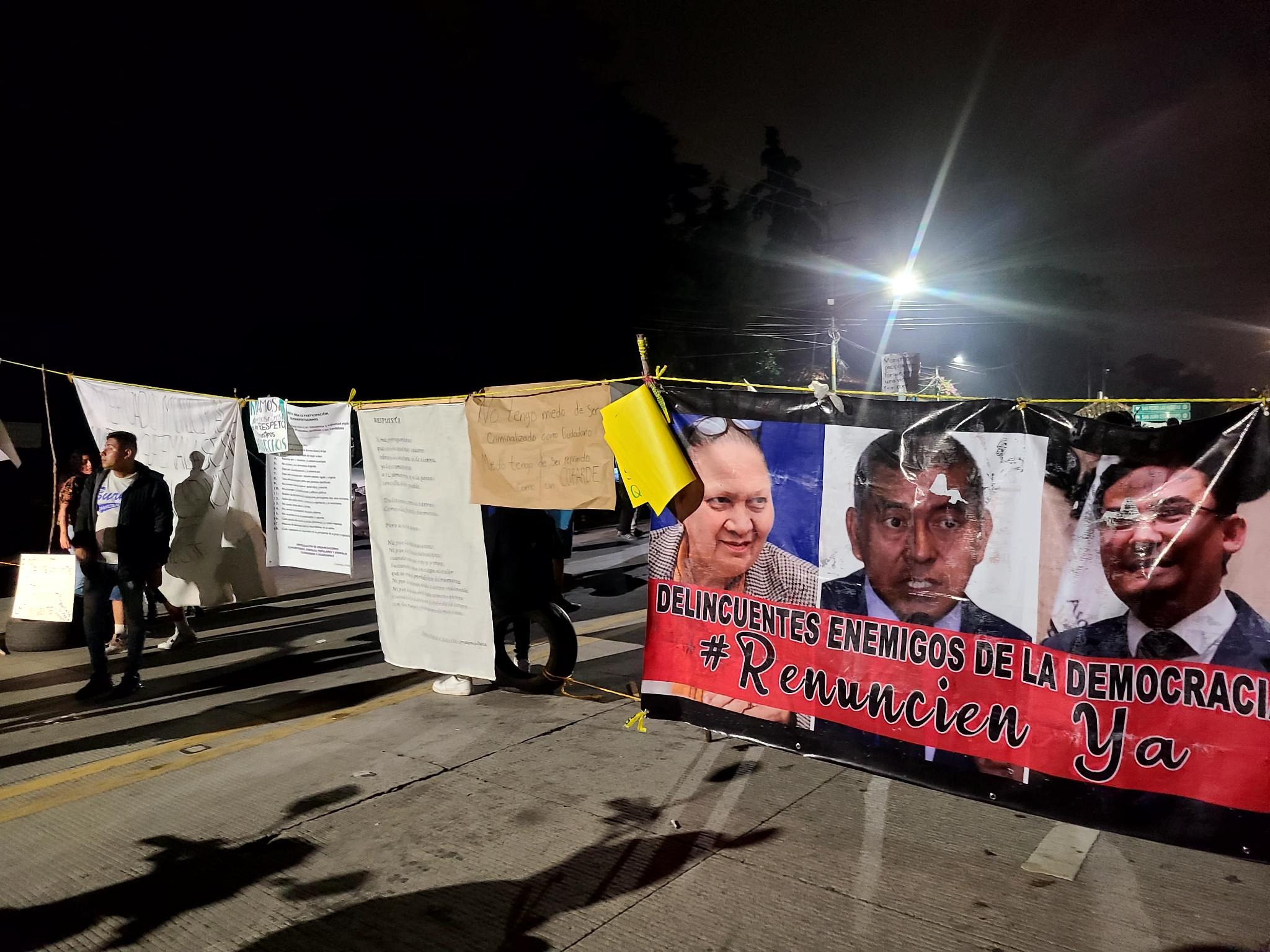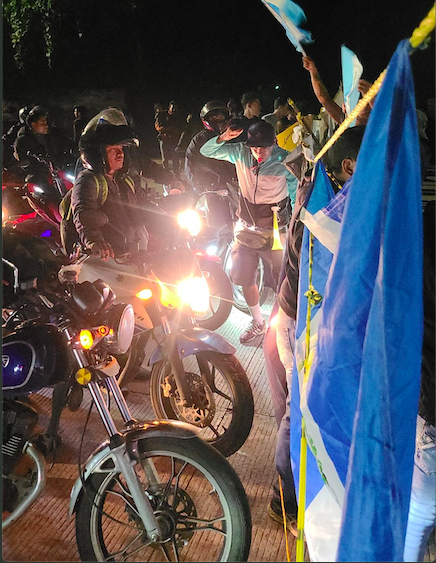October 2023
Natalie Brewster Nguyen
There was a moment when I could have gone, taken a car at midnight to get to the airport and see if I could get on a flight as planned, but everything was uncertain, and it didn’t feel right. I’m a revolutionary, and I wanted to support and participate as much as I could, and respect the fuck out of the blockades and the will of the people.
Editorial Note: The following dispatch was written by a comrade from Tucson who has found themself in the middle of an ongoing popular uprising while traveling in Guatemala. The revolt began on September 19, when thousands of farmers, Indigenous people, and others took to the streets in response to a call from President-elect Bernardo Arevalo for a popular response to election-meddling on the part of the outgoing, establishment regime. But, as always, the movement currently engulfing Guatemala is about much more than a particular politician. In early October, the movement began building barricades throughout the country and establishing infrastructure to hold territory and support the uprising longterm.
I arrived here in Kaqchikel Mayan lands aka Guatemala on the 28th of September on the next stop of a long and busy trip. I had planned to leave a week ago, but the day I was intending to leave was the first day of the blockades.
I came here to spend time with my daughter, who is 17 and moved here to study Spanish for the semester. After a lot of work and way too little sleep I arrived in Antigua, and was promptly whisked off to the Pacific coast, El Paredon, for a friend’s birthday. This was the typical surfer/backpacker scene with hot black sand beaches and treacherous ocean. It was beautiful, and bawdy, and we also witnessed someone drown in the rip currents on my 3rd day.
There, in these backpacker circles, there was little talk of the developing popular uprising. I had been doing my homework, and reminding myself of the important moments in Guatemalan history, US Imperialism and intervention, and anchoring some dates and names into my mind on my way here. It’s always odd to me how comfortable travelers are coming to a place without a basic understanding of history-how easy it is to coast by knowing so little.
After our sojourn at the beach, we were planning to return on October 3. The previous night, news of the blockades began to circulate. My colleague and I had a class to teach online on the 4th, so we were weighing options in terms of how we would get to somewhere with solid internet, if the blockades would affect travel, etc. I traveled in a shuttle back to Antigua on October 4 with no issues. But things were just beginning.
Antigua is a bit of a bubble in terms of its relationship to the rest of Guatemala. It is heavily touristed, and hosts a lot of foreign expats (I hate that word). And thus, some things are slower to arrive in Antigua than in other places. We watched and waited as the blockades were rolled out. It’s been beautiful, powerful, and an honor to witness the strategy of the people. They began first blockading particular thoroughfares and then expanding day by day, increasing the sites, increasing the sustainability of the movement and increasing the support available at each site.
Protesters line the streets in Antigua amidst a nationwide popular uprising. (Photo source: Natalie Brewster Nguyen).
There was a moment when I could have gone, taken a car at midnight to get to the airport and see if I could get on a flight as planned, but everything was uncertain, and it didn’t feel right. I’m a revolutionary, and I wanted to support and participate as much as I could, and respect the fuck out of the blockades and the will of the people.
The next day, there was no leaving. The blockades had expanded and at one point over 140 blockades throughout the country were being reported. The energy in the streets was palpable. Even those not at the sites of blockades were talking about it, commenting, shouting “Guatemala Vive!” To anyone nearby.
The first day of the blockade here in Antigua was effective, and bare bones. Roads were blockaded with simple ropes and a few people standing in the road to enforce the blockade. By the 2nd and 3rd night, infrastructure had come alive. There was a well-organized area for childcare, music, D.J.s, dancing, performance, poetry, video projection, and more. Food was circulated. Water was circulated. A child who could not have been more than 10 was doing the rounds, first offering water and then collecting trash.
The energy shifted between celebratory fiesta (a massive “Zumba for the revolution” class and people dancing the macarena) to moments of collective grief. At one point a poet performed “Doscientos Años Que Gritan Lucha” by Irma Alicia Velásquez Nimatuj with two dancers improvising a heart wrenching interpretation.
“Quinientos dos años ha durado
la rebeldía de mujeres y hombres
en búsqueda de libertad
escapando del trabajo esclavo
rompiendo la servidumbre
interpretando la lengua ajena
reteniendo un retazo de tierra
rechazando la cruz y el evangelio
resistiendo la violencia”
“Five hundred and two years
the rebellion of women and men
has lasted
in search of freedom
escaping from slave labor
breaking bondage
interpreting the language of others
holding on to a patch of dirt
rejecting the cross and the gospel
resisting violence”
The police were present, but largely silent. The municipal police feel distanced from the military, the paramilitary and the elites. They still cause harm and repression, but at this moment the nature of the relationship between the police and the people felt different to me than it does in the States. On the first day of the blockade there was footage of the people walking the police lines back. On day 3 or 4, they started tear gassing the Capital, but I haven’t seen more of that in recent days.
At one point, I had a flight out again, so I decided to try going. I was lukewarm about it. I really didn’t want to go, but also have a million things I was expected to be home for. My friend and I left at 9:30 p.m., after the blockade here had opened for the night, and headed towards the city. We got about half way to San Lucas, and there was no going through. We parked the car and walked to the blockade. It’s a funny thing to be so elated that your plans have been foiled. I was on the verge of tears witnessing the strength of the people. It was music. It was kids playing ball in the street. It was soup and it was love and it was power.

A group of protestors stood in a circular huddle discussing. They stood in front of the rope hung with signs that were strung across the road indicating the blockade. Two comrades in balaclavas sat on the wall in the median between the two lanes of traffic. “Adelante!” They gestured me over to the area where a speaker was playing loud reggaeton. Big tarps were hung up high to keep out the rain. It’s the rainy season, and the protests have continued throughout the intermittent rain.
For context, if you aren’t familiar with Guatemalan history, in brief: Bernardo Arévalo is the son of Juan José Arévalo, the first president to be democratically elected in Guatemala after the revolution. Arévalo Sr. was an academic and “spiritual socialist” elected in 1945. His agrarian reforms lead to his successor, Arbenz, initiating Decree 900, which reallocated nearly 1.5 million acres of lands to peasants, mostly Indigenous, who had been without land since the colonization by the Spanish. Actual Land Back. To be clear, this was also a capitalist venture-something that was seen as necessary to increase the GDP and move Guatemala towards a communist revolution. This reform was only in place for 18 months but impacted 500,000 people and 100,000 families. This action was the impetus for the United Fruit Company to pressure the U.S. government to topple the socialist-leaning government of Guatemala. The CIA enacted operation PBSuccess (this is complex, look it up) and successfully brought down the Guatemalan revolution and ushered in 30 years of dictatorship. Arévalo Sr. was forced into exile, and the many years of corruption and repression have left the Guatemalan people angry, oppressed and ready for change.

Semilla, the party of Arévalo has been “suspended” due to accused election fraud, directed by the Attorney General and upheld by the high court. However, here in Guatemala, they do elections differently (and better) than we do in the states. Many candidates run, and then a second election is held between the two most popular. Arévalo came in second in the first popular election, and won by over 20% in the secondary election.
“Not even if Arévalo told us to stop the protests, we’re not going to do it,” said Luis Pacheco, president of Los 48 Cantones (K’iche), during a meeting, “The negotiation is between the Indigenous peoples and the government.”
This is an Indigenous-lead movement. Guatemala is at LEAST 43% Indigenous Mayan and that is likely an undercount. The second largest city, Xela (the Mayan name that it is commonly used, officially known as Quetzaltenango) is majority Indigenous. There is also a very wide split between the urban and rural areas.

An initial barricade, composed only of rope and banners with people standing behind them, spans a street in San Lucas Sacatepéquez. (Photo source:Natalie Brewster Nguyen).
Things to note:
-The protests are currently peaceful. Indigenous leaders stress this point consistently. Blockades allow ambulances, bomberos, and trucks carrying essential goods and fuel through. However “peaceful” is subjective, and those in power will always attempt to control the narrative.
-Export, trade and tourism have all been impacted, which impacts both local business owners, workers, and others. The CEO of a major agricultural exporter states that the movement is destroying families and crops and businesses. And while that is true in certain aspects, it feels very much to me like corporations using that line to plead for their own interests. As stated above the VAST MAJORITY of Indigenous folks, the working class, and other marginalized communities are deeply in support of this movement.
-After 30 days of protest, the government can declare a state of emergency or martial law and protests are no longer considered “peaceful.” At that point, much more violent repression may happen. I’m not saying to book a ticket here. Please get in touch with various Guatemalan Solidarity Groups and check on ways to support, but as this resistance continues, please keep your eyes on the struggle. There is a long history of disappearances and other repressive tactics in Guatemala.
-Pressure the US government to support Indigenous leaders, and their current demands. Support their sovereignty in particular around the right to consultation when mining companies or other extractive industries come to their territories. This right is often not upheld because of the widespread corruption, and Indigenous communities are also occupying multiple peaceful resistance camps to mining projects around the country. Urge the US government to withhold all military aid to the Guatemalan Government until democracy is upheld.

Appendix:
The following quotes are from a meeting on October 12 organized by Breaking the Silence Network in which multiple Indigenous leaders spoke and answered questions. They were translated into English by a translator, from which I recorded them. They are verbatim quotes, the line breaks indicate that they were said at different times during her talk, not all in a row. Any errors are my own.
“Movement leaders have a clear demand: for the Attorney General Consuelo Porras, a judge, and a prosecutor, to be removed. They say it is not about Arevalo or Semilla party specifically.” -Luis Pacheco, president of Los 48 Cantones (K’iche)
The following quotes are from Emy Gómez, Indigenous Leader, Xinka parliament:
“The Xinka parliament doesn’t support any particular political party. We are here to defend democracy.”
“60, maybe 70% of the Guatemalan people are out in the streets defending our spaces. So that for the first time in 50 years Guatemala can be free. We’ve suffered. We’re exhausted.”
“We’re standing here, we’re resisting here, we’re waiting for good news.”
“We’ve been feeding people, we’ve been feeding people 3 meals a day. We’ve been able to meet the needs of the people here in our resistance points.”
“We’re here 24 hours a day. Sometimes it might feel like the exhaustion could win. But we have folks who are elders, who are women, who are youth, who are there 24 hours a day, putting their bodies on the line.”
“They’re armed, and we’re not. They’re threatening us. But we’re not going to back down, not one step.”
“We have felt a lot of repression on the part of the government, and we’re on the 11th day, but it feels like we’re on the 1st day. The level of optimism is so high.”
“Defending democracy is a right. We can’t be afraid.”
